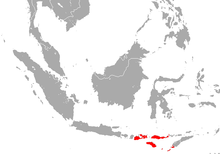The Sumba roundleaf bat (Hipposideros sumbae) is a species of bat in the family Hipposideridae.[1] It lives in Indonesia and East Timor.[2] It is present on the islands of Sumba, Rote, Sumbawa, Flores, Semau, and Savu.
| Sumba roundleaf bat | |
|---|---|
| Scientific classification | |
| Domain: | Eukaryota |
| Kingdom: | Animalia |
| Phylum: | Chordata |
| Class: | Mammalia |
| Order: | Chiroptera |
| Family: | Hipposideridae |
| Genus: | Hipposideros |
| Species: | H. sumbae
|
| Binomial name | |
| Hipposideros sumbae (Oei, 1960)
| |

| |
| Sumban leaf-nosed bat range | |
Taxonomy and etymology
editIt was initially described as a subspecies of the intermediate roundleaf bat (Hipposideros larvatus) in 1960 by Oei Hong Peng.[3][4] Its species name "sumbae" is derived from Sumba Island where the holotype was found.[4] As the genus Hipposideros is speciose, it is divided into closely related species groups— the Sumba roundleaf bat is in the larvatus species group.[5]
Biology
editIt is nocturnal, roosting in sheltered places such as caves and houses during the day. It likely roosts in large colonies. It is insectivorous.[1]
Conservation
editIt is currently evaluated as least concern by the IUCN. It is locally common and it tolerates human modification of the landscape, as evinced by it roosting in houses sometimes. It may be declining due to the mining of limestone from its caves.[1]
References
edit- ^ a b c d Santiago, K.; Wortham, G.; Gill, J.; Waldien, D.L. (2021). "Hipposideros sumbae". IUCN Red List of Threatened Species. 2021: e.T10164A22099540. doi:10.2305/IUCN.UK.2021-3.RLTS.T10164A22099540.en. Retrieved 17 December 2023.
- ^ "Report of Findings on the Proposed Iralalaro Hydro-ElectricPower Scheme, Timor-Leste" (pdf; 3,2 MB). Haburas Foundation and the Australian Conservation Foundation. Retrieved 9 August 2013.
- ^ Oei Hong Peng (1960). "Notes on bats from Bali, Lombok and Sumba". Hermera Zoa. 67 (28): 23–32.
- ^ a b Kitchener, D. J.; Maryanto, I. (1993). "Taxonomic reappraisal of the Hipposideros larvatus species complex (Chiroptera: Hipposideridae) in the Greater and Lesser Sunda Islands, Indonesia". Records of the Western Australian Museum. 16 (2): 119–173.
- ^ Murray, Susan W; Campbell, Polly; Kingston, Tigga; Zubaid, Akbar; Francis, Charles M; Kunz, Thomas H (2012). "Molecular phylogeny of hipposiderid bats from Southeast Asia and evidence of cryptic diversity". Molecular Phylogenetics and Evolution. 62 (2): 597–611. doi:10.1016/j.ympev.2011.10.021. PMID 22079552.
